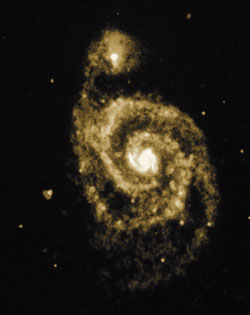We hardly think twice about seeing and interacting with events on the other side of Earth, not to mention with astronauts orbiting in space and robots on the surface of Mars.
|
 |
At radio wavelengths, the spiral pattern of the classic Whirlpool Galaxy appears as clearly as it does at visible wavelengths. Astronomers speculate that the galaxy's spiral structure is primarily due to its gravitational interaction with the smaller galaxy that lies behind it (right, top), which creates a spiral density wave. Since the pattern also shows up in radio emission, the magnetic fields in the Whirlpool may also be compressed by the density wave. |
Radio waves contain the lowest-energy photons of all electromagnetic radiation. These photons penetrate through vast reaches of gas and dust to give us deep views of our galaxy and the universe. Because most atoms and molecules barely interact with radio waves, the daytime sky is just as transparent to radio waves as the night sky. Therefore, radio astronomers can work 24 hours a day. Their observations have shown that the center of the Milky Way in particular shines brightly in radio waves. So do quasars, named for a shortened version of "quasi-stellar radio sources." For years these bright beacons were mysterious. We now believe they shine from the cores of extremely active galaxies, where massive black holes gobble matter with abandon.
Ever since the Italian engineer Guglielmo Marconi invented the wireless radio, communication via radio waves has become central to our civilization. We hardly think twice about seeing and interacting with events on the other side of Earth, not to mention with astronauts orbiting in space and robots on the surface of Mars. Giant radio telescopes detect faint transmissions from spacecraft in the outer solar system even though their signals are weaker than one-billionth of a watt by the time they reach Earth. Indeed, radio waves are the most likely means for us to make the ultimate long-distance call: detection of intelligent life in other planetary systems.
All branches of astronomy, from radio to optical to gamma ray, share the need to collect as many photons of light as possible. The universe is a busy place when it comes to light. Signals from distant objects can vanish easily in the hubbub. Light pollution in the night sky on Earth doesn't help, nor does the din of our communications technology. It's the classic cocktail-party challenge on a cosmic scale: To listen to one "conversation" among many--an asteroid beyond Neptune or a single remote galaxy--we must amplify its light as much as possible while suppressing the rest.
Galileo was the first to do this. In 1609 he developed a 1-inch-wide telescope that made objects appear 30 times closer to Earth than they appeared to the unaided eye. Since then, astronomers have made steady progress in building ever-larger telescopes to collect visible light. The largest optical telescopes in the world today are the Keck I (continued)
|

